Kerala Style Mutton Stew is a creamy, coconut-based dish with roots tracing back to European colonial kitchens in South India. Known locally as Mutton Ishtu.
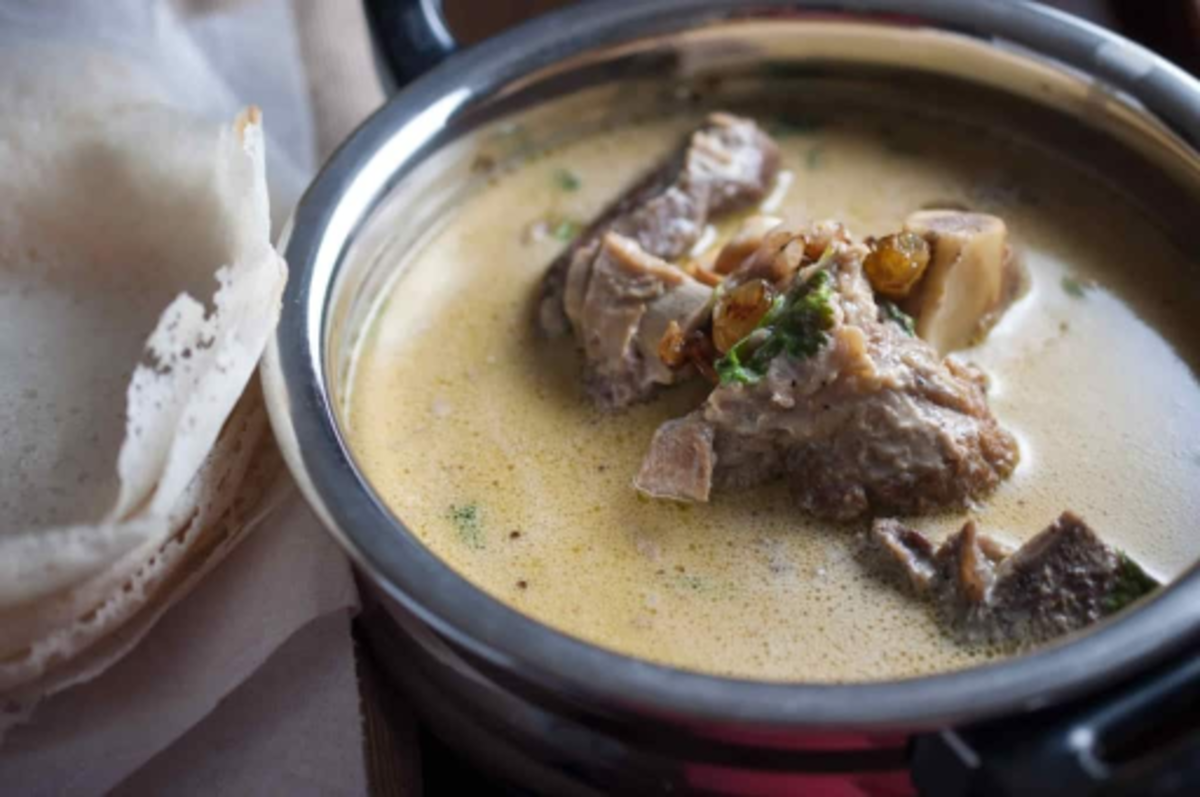
This dish fuses Kerala spices and cooking techniques with the concept of stews brought by British and Portuguese settlers.
It’s most popular in Central Kerala. Check out the full recipe, with clear cooking instructions, recommended sides, and storage tips to serve it just like in a Kerala home.
Jump to:
- What is Kerala-style mutton stew?
- Why You'll Love This Recipe?
- Recipe Ingredients
- Variations to Try
- How To Make Kerala Style Mutton Stew? (Step-by-Step Guide)
- Tips And Tricks
- Serving Suggestions
- Storage Instructions
- Frequently Asked Questions (FAQ)
- More Kerala Style Stew Recipes To Try
- Kerala Style Mutton Stew
What is Kerala-style mutton stew?
Kerala Style Mutton Stew is a creamy dish made with tender mutton, coconut milk, and spices. It's different from spicier Kerala curries because it has a rich coconut base that gives the meat a nice flavor. This makes it taste balanced and comforting.
The stew starts with mutton simmered in coconut milk. Kerala spices add flavor, but the coconut makes them less hot. This creates a smooth broth that's different from the region's bolder curries.
The coconut milk adds a natural sweetness. It balances the spices, making the dish versatile. If you love coconut milk-based dishes, be sure to check out our Kerala-style duck stew recipe.
You can enjoy it for breakfast, lunch, or dinner. It's a Kerala favorite that soothes and satisfies.
It's popular in Central Kerala (Kottayam, Ernakulam, Thrissur). People enjoy it during Easter and Christmas throughout the state. Common pairings are Appam, Idiyappam, and Bread. In the Malabar region (Kannur, Kozhikode, Kasaragod), it's also paired with Pathiri.
Why You'll Love This Recipe?
People like this dish for its rich, creamy, and mildly spiced flavors. The coconut milk makes it smooth and velvety. Kerala spices add warmth and depth without overpowering the dish.
The fat from the mutton makes it richer, creating a comforting and satisfying meal. Its wholesome qualities make it a standout in our Kerala Christmas and Easter recipes, perfect for gatherings.
It's also gluten-free, making it a versatile option for anyone looking for delicious gluten-free recipes.
Kerala Style Chicken Stew is another popular dish in this category.
Recipe Ingredients
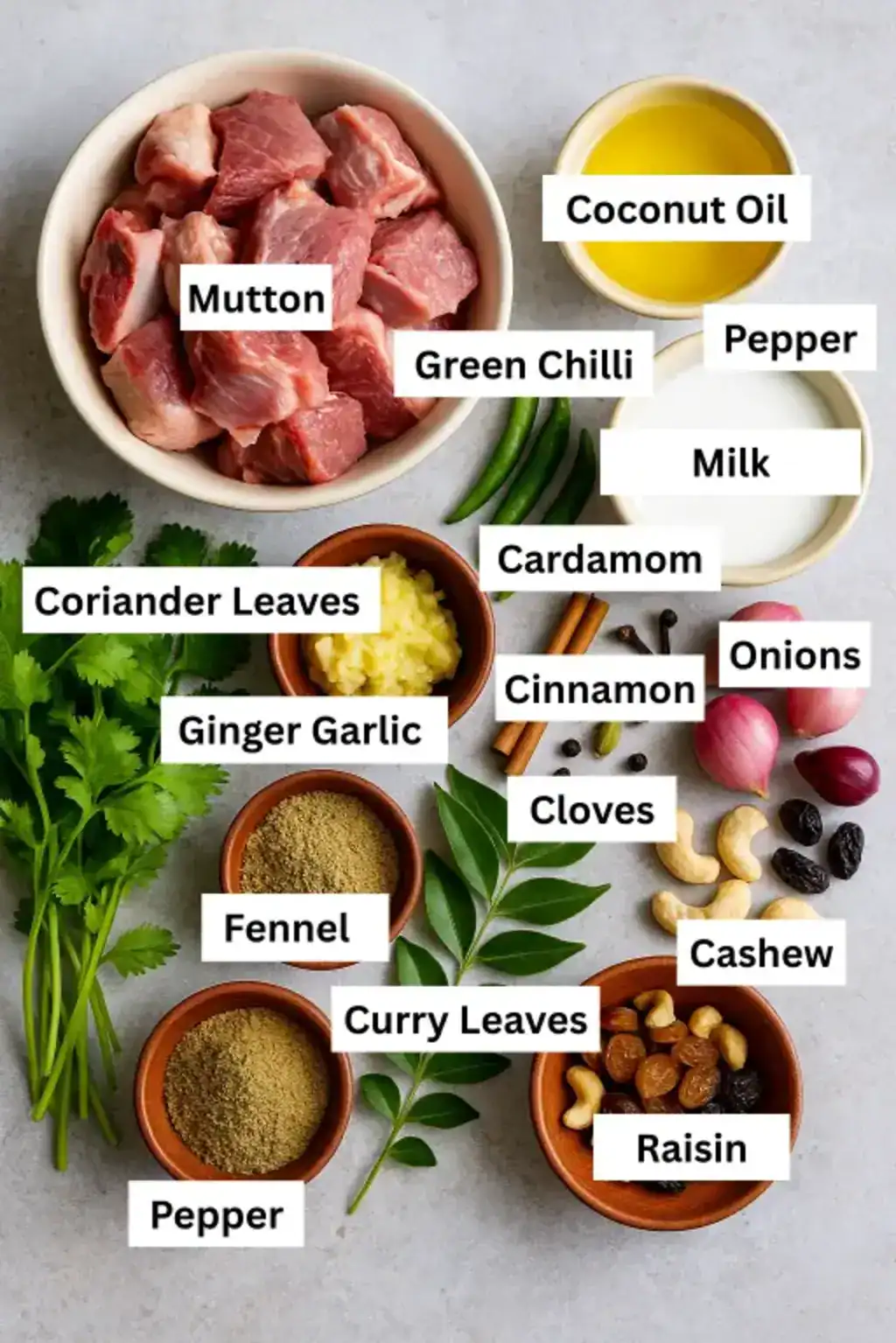
- Mutton – In India, mutton typically refers to goat meat, though you can also use lamb. Bone-in mutton is recommended for enhanced flavor. Fresh meat is always the best choice.
- Grounded Spices – The key powdered spices used in this dish are turmeric powder, pepper powder, coriander powder, and fennel powder (also known as perinjeerakam powder).
- Whole Spices – Essential whole spices include cloves, cinnamon, pepper, and cardamom. Whole spices are preferred over powdered ones, as they release a more intense aroma during cooking.
- Coconut Milk – Traditional cooking requires two types of coconut milk:
- First Extract (Thick Coconut Milk) – This is the first blend of coconut with water, which is then strained to yield thick coconut milk.
- Second Extract (Thin Coconut Milk) – After the first extraction, water is added to the residue and blended to make the thin coconut milk.
The thick coconut milk is added first, while the thin coconut milk is added later in the dish. - Canned Coconut Milk – While you can use canned coconut milk as an alternative, it’s not recommended for the most authentic taste.
Check out the Recipe Card below for the complete ingredient list along with their nutritional details.
Variations to Try
For Kerala-style stew, you can use chicken, beef, or duck. This dish has variations. Some people add tomatoes for tartness, while others include green peas, potatoes, and carrots. This makes it more flavorful.
Remember to add vegetables last because they cook differently from mutton.You can skip the protein and make a vegetable stew instead. Common vegetables used are carrots, potatoes, green beans, and legumes.
No matter the variation, the base of Kerala stew stays the same—coconut milk and Kerala spices. You might also want to try our Kerala Style Fish Stew recipe.
How To Make Kerala Style Mutton Stew? (Step-by-Step Guide)
- Heat oil in a pressure cooker. Add cloves, cardamom, cinnamon, and fry for a minute.
- Slit green chillies. Thinly slice the onions. Add onion, green chilli, curry leaves and salt.
- Sauté it until the onion is soft and translucent. Don't let it brown.
- Crush/grind ginger and garlic. Fry it well for a couple of minutes.
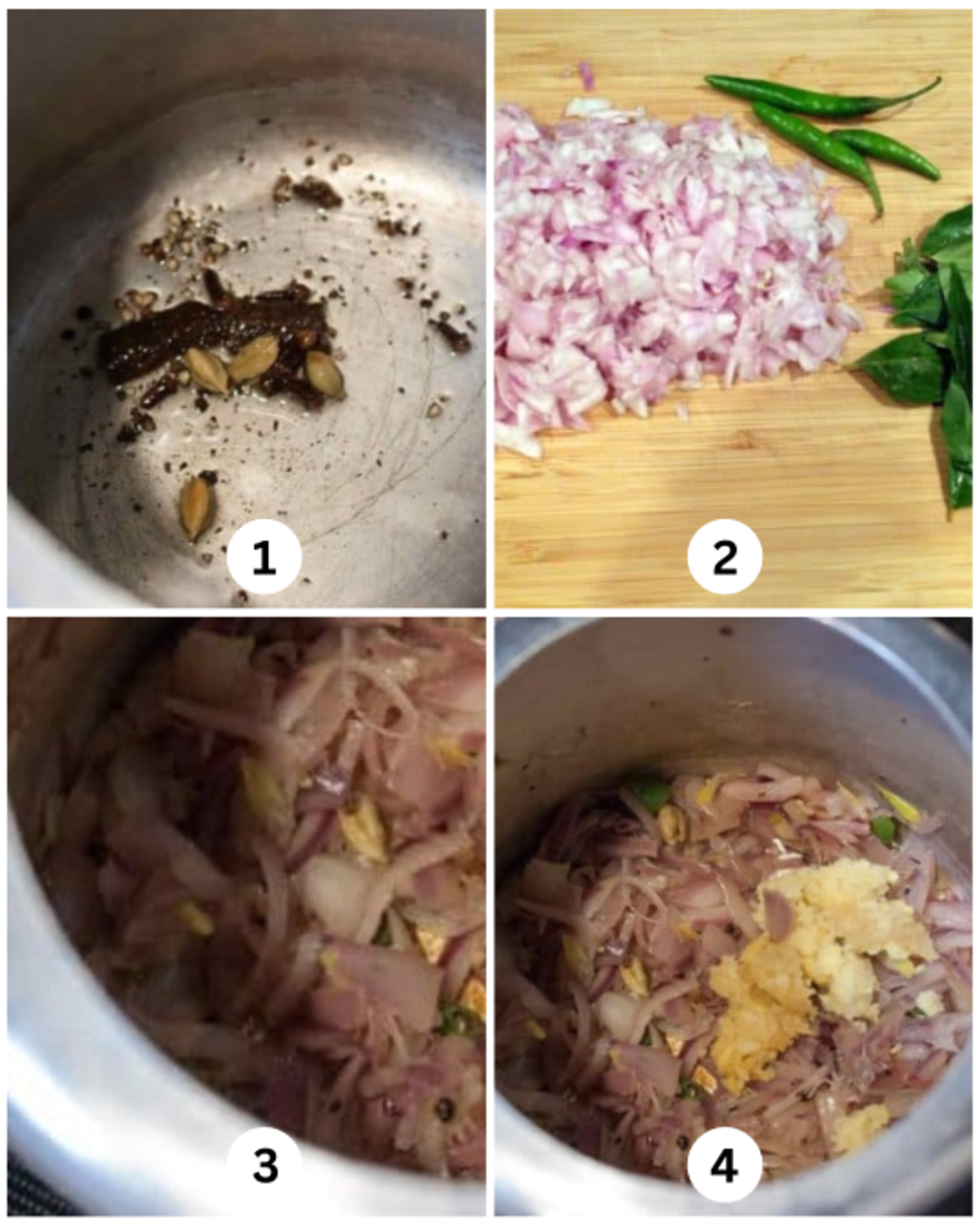
- Add the spice powders - freshly crushed whole pepper, pepper powder, fennel powder, and coriander powder. Fry the spice powders for 2 minutes.
- Clean the mutton pieces and drain the water. Add mutton, ¼ cup water, salt, and mix it well. Pressure-cook for around four whistles, or until meat is cooked. Don't overcook. Mutton has a lot of fat, and it would be melted by this time. For the ultimate Kerala cuisine and mutton combo, try our Kerala Style Mutton Biryani recipe.
- Either use the same cooker or transfer the above mutton with gravy to another pan for the rest of the preparation. Add thin coconut milk (second extract). Adjust salt and pepper. Let it cook for 5 minutes. Then add thick coconut milk (first extract). Mix it well.
- Add coriander leaves. Bring it to a boil and then switch it off. Coriander leaves are optional.

- Garnish - Chop shallots. In a small pan, add 2 teaspoons of oil. Fry shallots. Keep it aside. Fry cashew nuts and raisins in the same pan one after the other.
- Add the garnish to the stew. Serve Kerala-style Mutton Stew with Appam, Idiyappam, puttu or bread.

Tips And Tricks
- For a hint of tartness, add tomatoes.
- Use fresh, bone-in mutton to extract deep flavors from the bones and collagen.
- Toast whole spices and ground spices separately to release their aroma.
- If you want the stew to be creamier, soak 1 tablespoon cashew in 2 tablespoon hot water for 15 minutes. Grind it to a smooth paste. Add cashew paste at the end to thicken it more.
- Preparation of coconut milk from grated coconut - Grind 3 cups of grated coconut with 1 cup of lukewarm water. 1 cup thick coconut milk can be extracted from this. Lukewarm water helps you to extract coconut milk well. Grind the same coconut with 2 cups lukewarm water. 2 cups medium thick coconut milk can be prepared from this.
For more hearty and flavorful options, check out our Kerala Non-Veg Recipes.
Serving Suggestions
Mutton Ishtu pairs well with appam, bread, pathiri, and idiyappam because they absorb the stew nicely. It also goes well with Kerala steamed rice or ghee rice, served with pickles and crispy pappadam for a full meal.
You can also have it with chapatis, naan, rotis, or parathas, making it a versatile dish for any occasion.
Storage Instructions
Store Kerala-style mutton stew in an airtight container and refrigerate for 2-3 days. Reheat in a pan or microwave. If it thickens, add a splash of warm water to adjust the consistency.
Avoid freezing, as the coconut milk may split. For a longer shelf life, try our Authentic Kerala Style Mutton Curry recipe, which can be frozen for future use.
Frequently Asked Questions (FAQ)
Add the second coconut milk towards the end of cooking to avoid splitting. Once the coconut milk is added, avoid cooking at a high flame. Keep the flame low and cook gently. Stir the mixture occasionally, but avoid vigorous stirring.
Add cashew paste. The cashew paste is made by grinding soaked cashews with a little water. Add this paste along with the second extract of coconut milk during the cooking process for a richer texture.
More Kerala Style Stew Recipes To Try
I’d love to hear your thoughts if you have tried this! Please leave a ⭐️ rating and a comment below. Don’t forget to share your photos on Instagram and tag @a_little_bit_of_spice
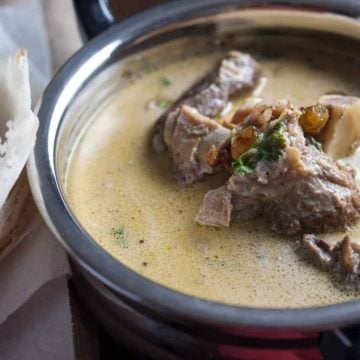
Kerala Style Mutton Stew
Ingredients
- ½ kilogram mutton
Gravy
- 1 number onion (medium)
- 3 numbers green chilli green
- 1 tablespoon garlic (crushed)
- 1 tablespoon ginger (crushed)
- 2 numbers cinnamon (1 inch stick)
- 2 numbers cardamom
- 5 numbers Cloves
- 1 teaspoon black pepper whole
- ½ teaspoon black pepper powder
- 2 teaspoon fennel powder
- 1 tablespoon coriander powder
- 2 sprigs curry leaves
- 1 cup coconut milk medium thick
- 1 cup coconut milk thick
- coriander leaves (optional)
- salt
- coconut oil
Garnish
- 5 numbers shallot
- 1 tablespoon cashew nut
- ½ tablespoon raisin
Instructions
- Heat oil in a pressure cooker. Add cloves, cardamom, cinnamon and fry for a minute.
- Slit green chillies. Thinly slice the onions. Add onion, green chilli, curry leaves and salt.
- Saute it until the onion is soft and translucent. Don't let it brown.
- Crush/grind ginger and garlic. Fry it well for couple of minutes.
- Add the spice powders - freshly crushed whole pepper, pepper powder, fennel powder and coriander powder. Fry the spice powders for 2 minutes.
- Clean the mutton pieces and drain the water. Add mutton, ¼ cup water, salt and mix it well. Pressure cook for around four whistles or until meat is cooked. Don't overcook. Mutton has lot of fat and it would be melted by this time.
- Either use the same cooker or transfer the above mutton with gravy to another pan for the rest of the preparation. Add medium thick coconut milk. Adjust salt and pepper. Let it cook for 5 minutes. Then add thick coconut milk. Mix it well.
- Add coriander leaves. Bring it to boil and then switch off. Coriander leaves is optional.
- Garnish - Chop shallots. In a small pan, add 2 teaspoons oil. Fry shallots. Keep it aside. Fry cashewnut and raisins in the same pan one after the other.
- Add the garnish to the stew. Serve with Appam, Idiyappam, puttu or bread.
Notes
- For a hint of tartness, add tomatoes.
- Use fresh, bone-in mutton to extract deep flavors from the bones and collagen.
- Toast whole spices and ground spices separately to release their aroma.
- If you want the stew to be creamier, soak 1 tablespoon cashew in 2 tablespoon hot water for 15 minutes. Grind it to a smooth paste. Add cashew paste at the end to thicken it more.
- Preparation of coconut milk from grated coconut - Grind 3 cups of grated coconut with 1 cup of lukewarm water. 1 cup thick coconut milk can be extracted from this. Lukewarm water helps you to extract coconut milk well. Grind the same coconut with 2 cups lukewarm water. 2 cups medium thick coconut milk can be prepared from this.
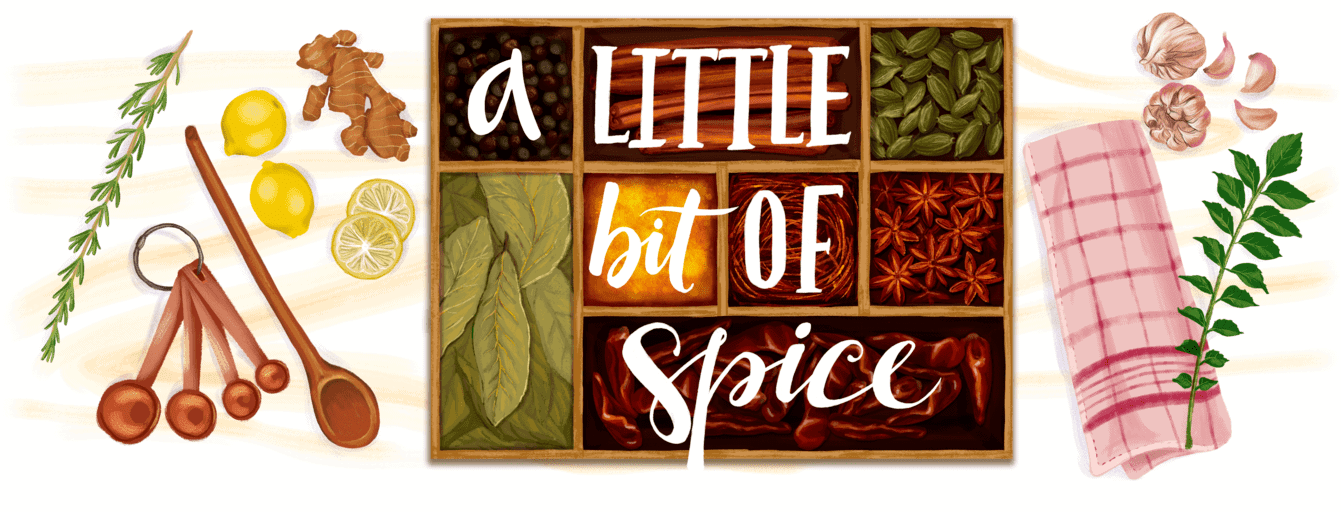



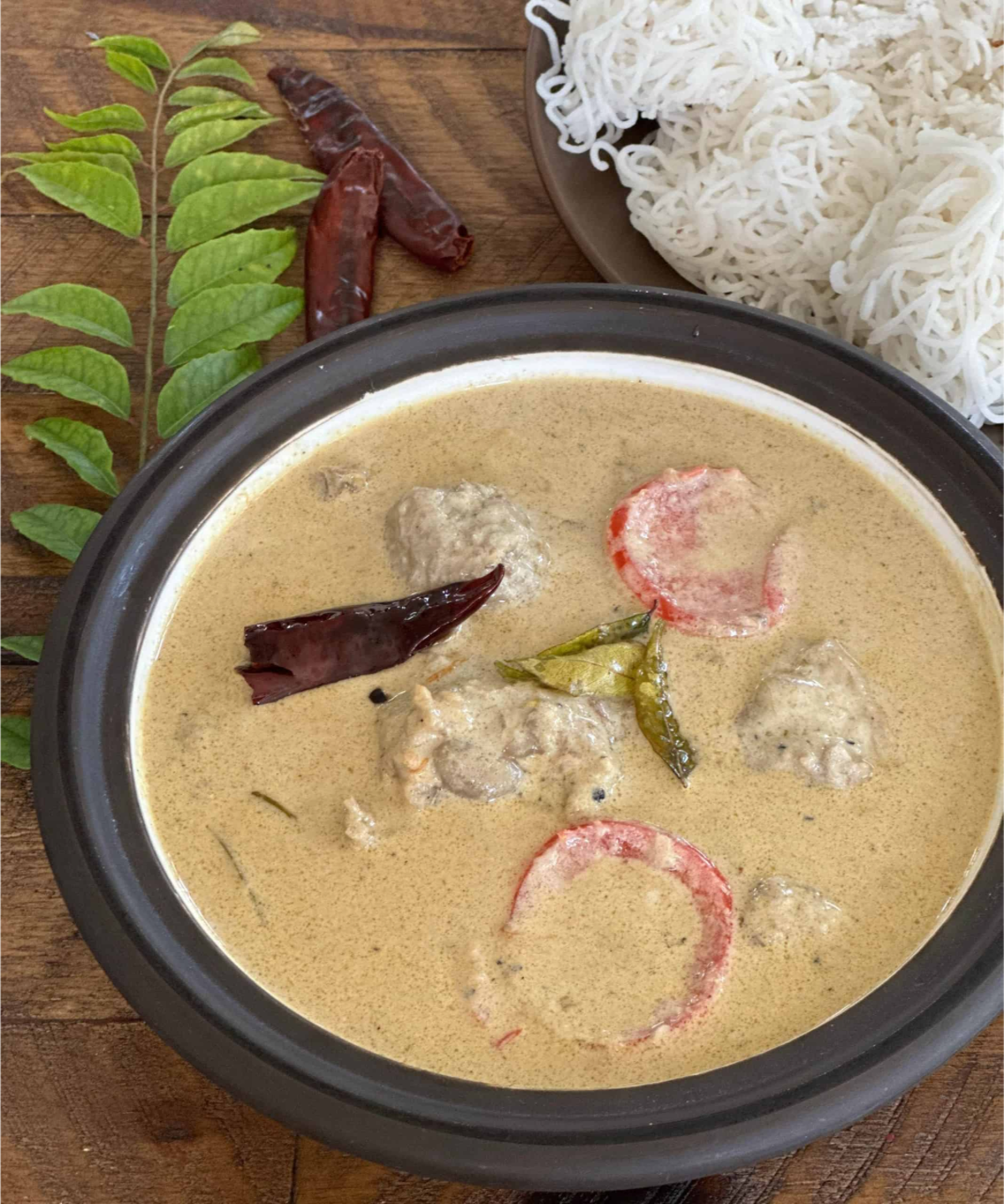

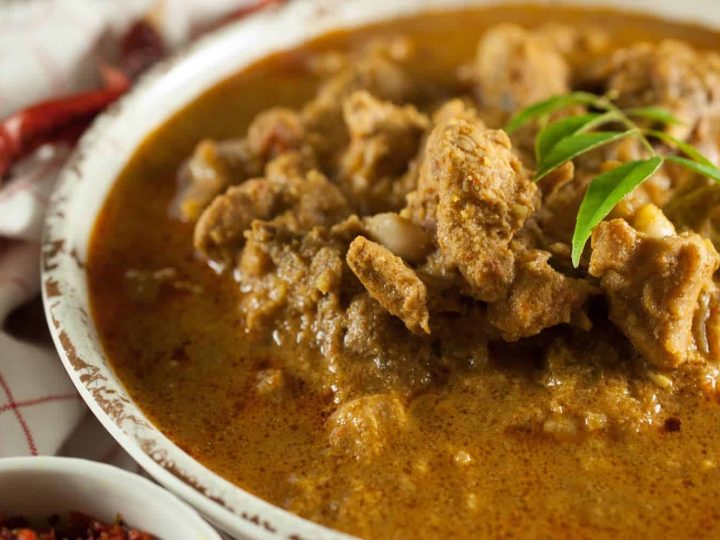



Very nice....I tried and loved it
Thanks for trying it out, Suhas. Glad that you liked it.
Very nice.. came out just like I expected it to be
Thanks Simran! Great to hear that you liked it.
This was amazingly simple and easy to try. The end result was also good. Thanks.
Thanks for trying it out Manoj! Good to know that you liked it.
I loved ur recipe. It is so yummy. Yr step by step by step instructions are so easy to follow.. Even Yr quantities are just right for a small 👪.
Thanks a lot Rani! Happy to hear that you loved it :)
It came out well. I cooked for 2kg mutton, i used less amount of thick coconut milk, thats why my stew looks darker in colour. But the taste was awesome. Thanks Jane!
U made my easter breakfast yummy!! Happy easter!
Great to hear that, Jincy Thanks for trying out my recipe!
Thanks for trying out my recipe!
5 stars… love this recipe very much… turned out well… creamy and delicious. My family loves it so much… thank you… its super easy to follow your recipe… hats off…